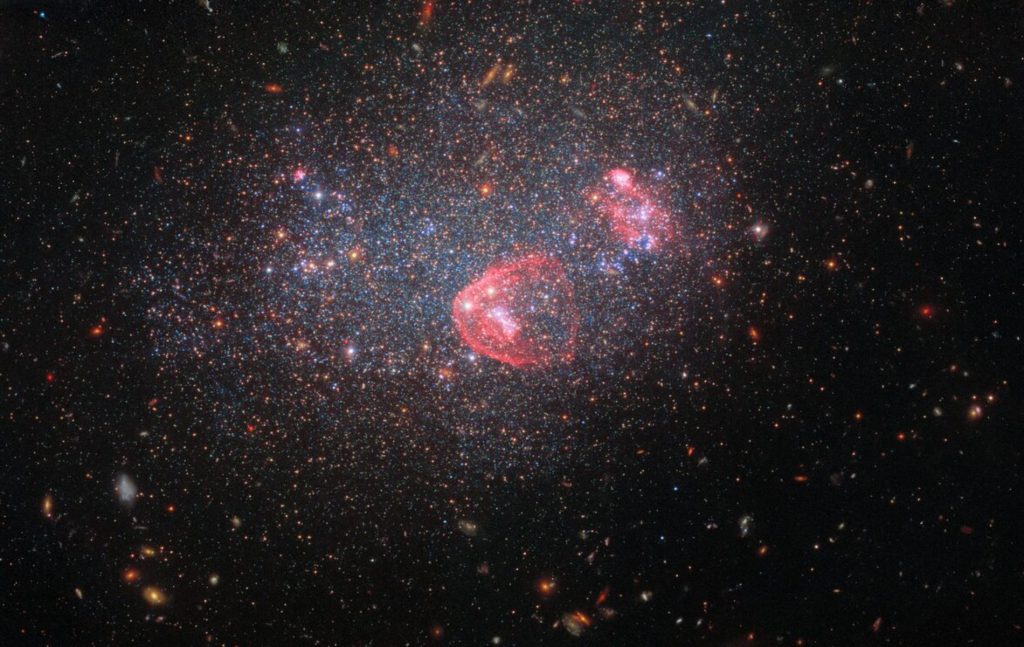In honor of the upcoming holidays, the space telescope captured an image of the galaxy UGC 8091, rich in countless sparkling stars.
About seven million light-years away, in the constellation Virgo, we find the impressive galaxy UGC 8091. With the holidays approaching, the Hubble Space Telescope has now captured a beautiful image of this galaxy. It is not incomprehensible that the telescope would focus its eyes on this system. Because all those countless points of light remind us of a beautiful snow globe.
picture
The beautiful photo can be seen below. The image is due to two advanced instruments that the Hubble Telescope is equipped with: Wide range camera 3 And the Advanced camera for surveys. Using advanced filters in scientific instruments, an impressive range of wavelengths of light was captured. This allows scientists to study millions of stars in this galaxy better than ever before.
Irregular galaxy
Unlike other galaxies with ordered stars, UGC 8091 is considered an irregular galaxy by astronomers. And it's not hard to see why: The stars that make up this galaxy look more like bright Christmas lights or floating particles in a snow globe than a traditional galaxy. Some irregular galaxies have been disrupted by turbulent internal events, while others were formed through interactions with neighboring galaxies. This creates galaxies of different sizes and shapes, including the scattered star brilliance that characterizes this particular galaxy.
A billion stars
More precisely, UGC 8091 is a so-called irregular dwarf galaxy. This means it is home to only about a billion stars. This may seem like a lot, but it's modest for a galaxy: our Milky Way, for example, contains more than 100 billion stars, and other galaxies may contain trillions of stars! Dwarf galaxies usually orbit larger galaxies. Because of their small mass, they are sensitive to disruption and absorption by their larger neighbors. This process results in small, irregular, distorted galaxies, such as UGC 8091.
Similar properties
Dwarf galaxies are actually very interesting. It is believed that this type of galaxy has properties similar to the ancient and very distant galaxies that astronomers observe in the so-called “deep field images”. It is hoped that examining the composition of dwarf galaxies and their stars will help understand the evolutionary links between these ancient galaxies and more modern galaxies, such as our own.
Mineral
It is easy to explain why scientists are interested in dwarf galaxies. Because such galaxies, ancient and distant galaxies, have striking similarities. For example, dwarf galaxies have low metal content or metallicity. Metallicity is a way of indicating how much of a star is composed of elements heavier than helium and hydrogen. These heavier elements are formed in the core of stars. The first generation of stars in the universe were low in metallicity, because there were no previous stars that could produce these heavier elements. By studying dwarf galaxies, researchers also hope to learn more about ancient and distant galaxies.
Thus, the newly released image has not only aesthetic purpose, but also of great scientific interest. It allows astronomers to carefully study the colorful stars in UGC 8091 and learn more about this galaxy. Using different filters, researchers can observe different features of the galaxy. The filtered images are then combined to create a full color image. And take a closer look. The bright, vibrant red spots represent light from hydrogen molecules in hot new stars that have just formed. The other bright spots are from older stars.
With the beautiful image of UGC 8091, the Hubble Telescope heralds the upcoming holidays in an impressive way. At the same time, this image gives us more knowledge about irregular dwarf galaxies. Although they may seem simple, these galaxies contain an amazing amount of information about our universe. Therefore, they are as valuable as other objects in the night sky.

“Coffee buff. Twitter fanatic. Tv practitioner. Social media advocate. Pop culture ninja.”










More Stories
Which can cause an increase in nitrogen.
The Central State Real Estate Agency has no additional space to accommodate Ukrainians.
The oystercatcher, the “unlucky national bird,” is increasingly breeding on rooftops.